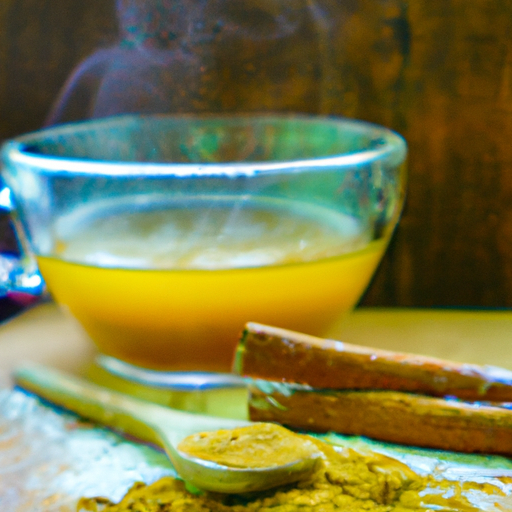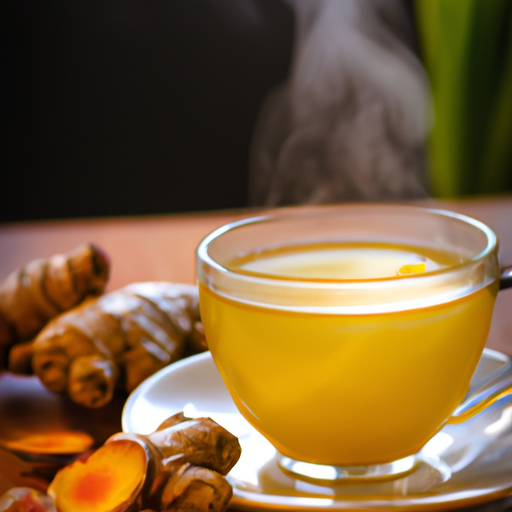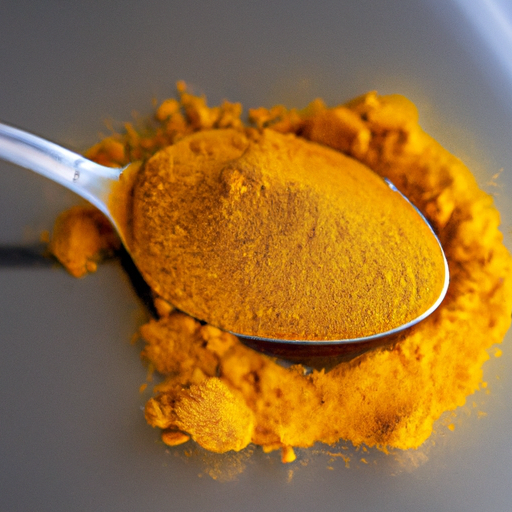If you’re in search of a cozy and soothing beverage that is also packed with health advantages, turmeric tea could be the perfect choice. Turmeric has been utilized for centuries in Ayurvedic and traditional medicine due to its anti-inflammatory and antioxidant properties.
While fresh turmeric root is the traditional ingredient used to make turmeric tea, you can also use turmeric powder if that’s what you have on hand.
To make turmeric tea with powder, you’ll need to gather your ingredients and prepare your turmeric powder first. Then, you’ll add sweeteners and spices to taste, along with milk if you prefer a creamier texture.
After straining your tea, you’ll be ready to enjoy all the health benefits that turmeric has to offer, from reducing inflammation to supporting digestion and even potentially reducing the risk of chronic diseases.
However, it’s important to be aware of potential side effects and precautions before adding turmeric to your diet, and to consult with a healthcare professional if you have any concerns.
Key Takeaways
- Turmeric tea can be made with either turmeric powder or fresh turmeric root.
- Turmeric tea has numerous health benefits, including anti-inflammatory and antioxidant properties.
- Natural sweeteners and spices can be added for flavor and additional health benefits.
- The recommended dosage is 1-2 teaspoons of turmeric powder per cup of water, and it is generally safe to consume up to 3 cups per day.
Gather Your Ingredients
You’re ready to make turmeric tea with powder, but first, you need to gather your ingredients. Choosing the right turmeric powder is crucial for the taste and health benefits of your tea.
You may also want to consider your preferred sweeteners and spices, as well as the type of milk base you’ll use. By being intentional with your ingredient choices, you can create a delicious and nourishing cup of turmeric tea.
Selecting the Right Turmeric Powder
Choosing the perfect turmeric powder can enhance the flavor and health benefits of your homemade turmeric tea. Here are three things you should keep in mind when selecting turmeric powder for your tea:
-
Turmeric Powder Quality: Look for turmeric powder that’s organic, non-irradiated, and non-GMO. This ensures that the powder is free of harmful chemicals and additives that may affect its quality.
-
Storage Tips: Check the expiration date on the turmeric powder before purchasing it. Also, make sure that the powder is stored in a cool, dry place away from direct sunlight. This will prevent the powder from losing its flavor and color.
-
Color and Aroma: The color of the turmeric powder can give you an idea of its freshness. Fresh turmeric powder should be bright yellow-orange in color. Also, the aroma of the powder should be strong and spicy. If the powder smells musty or stale, it may not be fresh.
Now that you know how to select the right turmeric powder, it’s time to choose your preferred sweeteners and spices to add to your tea.
Choosing Your Preferred Sweeteners and Spices
When it comes to spicing up your turmeric tea, there are plenty of options beyond just sugar. Alternatives like honey, maple syrup, or stevia can add a touch of sweetness without the negative health effects of refined sugar.
Additionally, spices like ginger, cardamom, or nutmeg can complement the earthy flavor of turmeric while also providing their own unique health benefits. Ginger, for example, has anti-inflammatory properties that can further enhance turmeric’s own anti-inflammatory effects. Meanwhile, cardamom has been shown to improve digestion and may even have cancer-fighting properties.
By experimenting with different sweeteners and spices, you can customize your turmeric tea to your own tastes and health needs. With your spice blend chosen, it’s time to move on to selecting your milk base.
Selecting Your Milk Base
Now it’s time to consider what kind of milk you want to use as the base for your delicious turmeric drink. Milk is an excellent source of calcium, protein, and other essential nutrients that are beneficial for your overall health.
Here are three things to consider when selecting your milk base:
-
Benefits of milk: Cow’s milk is the most commonly used milk for making turmeric tea. It has a creamy texture and a mild taste that complements the earthy flavor of turmeric. Additionally, milk contains casein, a protein that helps slow down the absorption of turmeric into your bloodstream, allowing your body to absorb more of its health benefits. If you’re lactose intolerant, you can opt for lactose-free milk or try other dairy alternatives.
-
Alternatives to milk: If you prefer a dairy-free option, you can use nut milk, such as almond or cashew milk, as a base for your turmeric tea. Nut milk is low in calories and has a nutty flavor that pairs well with turmeric. Additionally, it’s a good source of healthy fats and antioxidants that can benefit your health. You can also use coconut milk, which has a rich and creamy texture that adds depth to the flavor of your turmeric tea.
-
Personal preference: Ultimately, the type of milk you choose to use in your turmeric tea depends on your personal preference. Experiment with different types of milk until you find the one that best suits your taste buds and dietary needs.
Once you have selected your milk base, you can move on to the next step of preparing your turmeric powder.
Prepare Your Turmeric Powder
To get the most out of your turmeric powder when making tea, it’s important to prepare it properly. First, make sure you’re using a high-quality turmeric powder from a reputable brand. Look for brands that use organic, non-GMO turmeric and avoid any that contain additives or fillers.
Once you have your turmeric powder, it’s important to store it in an airtight container away from sunlight. This will help preserve its flavor and potency. When it comes time to make your turmeric tea, measure out the desired amount of powder and mix it with hot water. You can also add black pepper to increase turmeric’s bioavailability.
Now that your turmeric powder is prepared, it’s time to add sweeteners and spices to make a delicious and healthy tea.
Add Sweeteners and Spices
Enhance the flavor and nutritional value of your turmeric beverage by incorporating natural sweeteners and spices. While turmeric on its own has a slightly bitter taste, adding a touch of sweetness can make it more palatable. Instead of using refined sugar, consider using alternative sweeteners like honey, maple syrup, or stevia. These natural sweeteners not only add a pleasant sweetness but also provide additional health benefits such as antioxidants and anti-inflammatory properties.
In addition to sweeteners, incorporating spice combinations can give your turmeric tea a more complex and interesting flavor. Traditional chai spices like cinnamon, cardamom, and ginger pair well with turmeric and can also provide additional health benefits. Try experimenting with different spice combinations to find the perfect blend for your taste preferences. After adding sweeteners and spices, it’s time to move on to the next step: adding milk.
| Sweeteners | Health Benefits |
|---|---|
| Honey | Antibacterial, Anti-inflammatory |
| Maple Syrup | Antioxidants, Anti-inflammatory |
| Stevia | Lowers Blood Pressure |
Imagery in the audience’s mind:
Imagine adding a tablespoon of golden honey to your warm turmeric tea. You stir it in until the honey dissolves, and the sweet aroma of honey wafts up to your nose. As you take a sip, you feel the warmth of the spices and the sweetness of the honey dance on your taste buds. It’s a comforting and nourishing experience for your body and soul.
Add Milk
Now let’s talk about adding milk to your tea. There are a variety of dairy and non-dairy options available, each with their own unique taste and nutritional benefits.
If you prefer a latte-style tea, you may want to experiment with frothing and steaming your milk to achieve the perfect texture and temperature. Keep in mind that the type of milk you choose and the way you prepare it can greatly impact the overall flavor and experience of your tea.
Dairy and Non-Dairy Options
You can easily create a creamy and dairy-free turmeric tea by using almond milk instead of regular milk. Plant-based alternatives are becoming increasingly popular for those who are lactose intolerant or simply want to reduce their dairy intake. Almond milk, in particular, is a great option as it has a naturally nutty flavor that pairs well with the earthy taste of turmeric.
To help you decide which milk alternative to use, we’ve put together a table comparing dairy and non-dairy options. It’s important to note that while dairy milk is a good source of calcium and vitamins D and B12, plant-based alternatives offer unique health benefits such as being lower in calories and cholesterol-free. Experiment with different milk options to find the perfect combination for your turmeric tea. Now, let’s move on to the next step of frothing and steaming.
Frothing and Steaming
Let’s get to the fun part of creating a creamy and delicious beverage by adding some frothed and steamed milk to our golden elixir. Turmeric tea can be made with different types of milk, including dairy and alternative options like soy, almond, or coconut milk.
Frothing techniques vary depending on the type of milk used, but the goal is to create a creamy texture that complements the earthy flavor of turmeric. To froth dairy milk, you can use a steam wand on an espresso machine or a handheld frother. For alternative milk options, it’s best to use a frother specifically designed for non-dairy milk. Keep in mind that different types of milk will produce different levels of frothiness, so experiment with the amount of froth to find your preferred texture.
Once the milk is frothed, pour it over your brewed turmeric tea and enjoy the creamy goodness. As you move on to the next step of straining and serving your turmeric tea, remember that the type of milk used can affect the final texture and taste of your drink.
Straining the tea helps remove any solids left from the turmeric powder, resulting in a smoother and more enjoyable experience. So, let’s strain and serve our delicious and healthy turmeric tea.
Strain and Serve
To get a smooth and satisfying turmeric tea, simply strain and serve the brewed powder mixture. After the tea has steeped for about 10-15 minutes, strain it through a fine-mesh sieve or cheesecloth to remove any remaining particles. This will ensure a smooth texture and prevent any gritty or unpleasant residue in your tea.
Once strained, you can serve your turmeric tea hot or cold. Some people prefer to add a touch of honey or a squeeze of lemon for extra flavor. Others like to mix in other spices like ginger or cinnamon for added health benefits and flavor. Experiment with different serving suggestions to find what works best for you. Now that you know how to properly strain and serve your turmeric tea, let’s explore its many health benefits.
Health Benefits of Turmeric Tea
Discover the numerous health benefits of incorporating turmeric into your daily routine by sipping on this delicious and soothing beverage. Turmeric tea recipes have been used for centuries in Ayurvedic medicine to treat a variety of ailments.
Here are three health benefits of turmeric tea that’ll make you want to start drinking it today:
-
Anti-inflammatory properties: Turmeric contains a powerful anti-inflammatory compound called curcumin, which has been shown to reduce inflammation in the body. Drinking turmeric tea regularly may help alleviate symptoms of chronic inflammation, such as joint pain and swelling.
-
Boosts immunity: Turmeric is packed with antioxidants and has immune-boosting properties. Regular consumption of turmeric tea may help improve overall immune function, making you less susceptible to infections and illnesses.
-
Promotes digestion: Turmeric tea has been used for centuries to aid in digestion. The compounds in turmeric may help stimulate the production of digestive juices, reducing symptoms of bloating, gas, and indigestion.
Incorporating turmeric tea into your daily routine is a great way to reap the numerous health benefits of this powerful spice. However, it’s important to be aware of the precautions and side effects before consuming turmeric tea.
Precautions and Side Effects
Before you start incorporating turmeric into your daily routine, it is important to be aware of the potential side effects and precautions that come with consuming this powerful spice. While turmeric is generally considered safe in small to moderate amounts, taking high doses or using it for long periods of time may cause unwanted effects. Some of the common side effects of turmeric include stomach upset, nausea, dizziness, and diarrhea. Additionally, turmeric may interact with certain medications, such as blood thinners, and may increase the risk of bleeding.
When it comes to turmeric tea, it is important to pay attention to the dosage and to consult with your healthcare provider if you have any concerns. The recommended dosage of turmeric tea is typically 1-2 teaspoons of turmeric powder per cup of water, and it is generally safe to consume up to 3 cups of turmeric tea per day. However, if you have high blood pressure or are taking medication to lower your blood pressure, it is important to be cautious with turmeric as it may cause a drop in blood pressure. Overall, turmeric can be a valuable addition to your diet, but it is important to use it in moderation and to be mindful of any potential side effects or interactions with medication.
Moving onto the next section, there are other creative and unique ways to incorporate turmeric powder into your daily routine.
Other Uses for Turmeric Powder
Hey, you! Want to add some flavor and spice to your meals? Turmeric powder is the perfect ingredient to give your dishes a little kick and add some health benefits too!
Aside from its anti-inflammatory and antioxidant properties, turmeric powder has been found to improve brain function, lower the risk of heart disease, and even aid in preventing and treating cancer.
To incorporate turmeric powder into your daily routine, try adding it to your morning smoothie or sprinkling it on your eggs for breakfast. It can also be added to soups, stews, and curries for a warm and earthy flavor.
Additionally, turmeric powder can be used to make a soothing and healing turmeric latte or tea. Just mix it with milk or water, add a dash of cinnamon or honey, and enjoy!
With so many benefits and versatile uses, turmeric powder is definitely worth incorporating into your daily routine.
Frequently Asked Questions
Can I use fresh turmeric root instead of powder in this recipe?
Substituting powder for fresh: Pros and Cons include convenience and shelf-life, but fresh turmeric may retain more of its natural compounds. Flavor differences between fresh and powdered turmeric include a stronger, earthy taste with fresh root.
How much turmeric powder should I use to make a single cup of turmeric tea?
Unlock the full potential of turmeric tea benefits by using the right amount of turmeric powder. For a single cup, start with 1/2 teaspoon and adjust to taste. Experiment with turmeric tea recipe variations to explore the full spectrum of its health benefits.
Can I use honey as a sweetener instead of sugar or stevia?
Yes, honey can be used as a sweetener in turmeric tea instead of sugar or stevia. Honey alternatives are commonly used due to the numerous health benefits they provide, such as antibacterial and anti-inflammatory properties.
Are there any specific types of milk that work best in turmeric tea?
Non-dairy alternatives like almond milk work great in turmeric tea. Milk can enhance the absorption of turmeric’s active compound, curcumin, which has anti-inflammatory and antioxidant properties. Consuming turmeric tea with milk may promote better health outcomes.
Is it safe to consume turmeric tea if I am taking certain medications or have certain medical conditions?
It’s important to be mindful of potential drug interactions and medical considerations before consuming turmeric tea. Some medications, such as blood thinners, may interact with turmeric. It’s best to consult with a healthcare provider before consuming turmeric in any form.
Conclusion
Congratulations! You’ve successfully made a delicious and healthy cup of turmeric tea using powder!
By following the simple steps outlined in this article, you’ve unlocked the full potential of this golden spice. With the addition of sweeteners and spices, you’ve customized your tea to your liking, making it the perfect addition to your daily routine.
But don’t stop here! Turmeric powder has many other uses. It can add flavor and color to your dishes, promote skin health, and reduce inflammation. Incorporating turmeric into your daily life can provide numerous benefits for your mind and body.
So go ahead, get creative, and explore the many wonders of turmeric powder. Your taste buds and your health will thank you!










